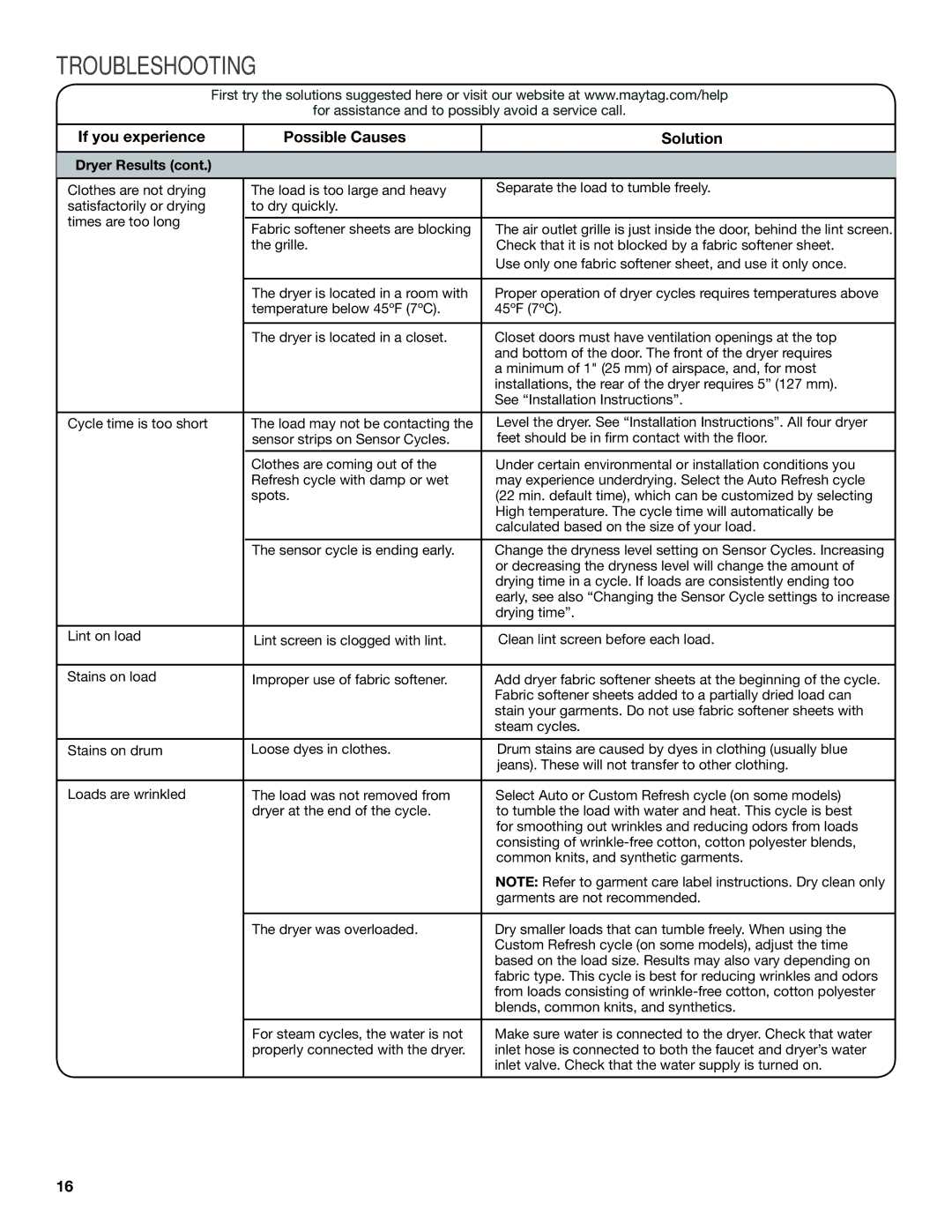
TROUBLESHOOTING
First try the solutions suggested here or visit our website at www.maytag.com/help
for assistance and to possibly avoid a service call.
If you experience
Possible Causes
Solution
Dryer Results (cont.)
Clothes are not drying | The load is too large and heavy | Separate the load to tumble freely. | |
satisfactorily or drying | to dry quickly. |
| |
times are too long |
|
| |
Fabric softener sheets are blocking | The air outlet grille is just inside the door, behind the lint screen. | ||
| |||
| the grille. | Check that it is not blocked by a fabric softener sheet. | |
|
| Use only one fabric softener sheet, and use it only once. | |
|
|
| |
| The dryer is located in a room with | Proper operation of dryer cycles requires temperatures above | |
| temperature below 45ºF (7ºC). | 45ºF (7ºC). | |
|
|
| |
| The dryer is located in a closet. | Closet doors must have ventilation openings at the top | |
|
| and bottom of the door. The front of the dryer requires | |
|
| a minimum of 1" (25 mm) of airspace, and, for most | |
|
| installations, the rear of the dryer requires 5” (127 mm). | |
|
| See “Installation Instructions”. | |
|
|
| |
Cycle time is too short | The load may not be contacting the | Level the dryer. See “Installation Instructions”. All four dryer | |
| sensor strips on Sensor Cycles. | feet should be in firm contact with the floor. | |
|
|
| |
| Clothes are coming out of the | Under certain environmental or installation conditions you | |
| Refresh cycle with damp or wet | may experience underdrying. Select the Auto Refresh cycle | |
| spots. | (22 min. default time), which can be customized by selecting | |
|
| High temperature. The cycle time will automatically be | |
|
| calculated based on the size of your load. | |
|
|
| |
| The sensor cycle is ending early. | Change the dryness level setting on Sensor Cycles. Increasing | |
|
| or decreasing the dryness level will change the amount of | |
|
| drying time in a cycle. If loads are consistently ending too | |
|
| early, see also “Changing the Sensor Cycle settings to increase | |
|
| drying time”. | |
|
|
| |
Lint on load | Lint screen is clogged with lint. | Clean lint screen before each load. | |
|
|
| |
Stains on load | Improper use of fabric softener. | Add dryer fabric softener sheets at the beginning of the cycle. | |
|
| Fabric softener sheets added to a partially dried load can | |
|
| stain your garments. Do not use fabric softener sheets with | |
|
| steam cycles. | |
|
|
| |
Stains on drum | Loose dyes in clothes. | Drum stains are caused by dyes in clothing (usually blue | |
|
| jeans). These will not transfer to other clothing. | |
|
|
| |
Loads are wrinkled | The load was not removed from | Select Auto or Custom Refresh cycle (on some models) | |
| dryer at the end of the cycle. | to tumble the load with water and heat. This cycle is best | |
|
| for smoothing out wrinkles and reducing odors from loads | |
|
| consisting of | |
|
| common knits, and synthetic garments. | |
|
| NOTE: Refer to garment care label instructions. Dry clean only | |
|
| garments are not recommended. | |
|
|
| |
| The dryer was overloaded. | Dry smaller loads that can tumble freely. When using the | |
|
| Custom Refresh cycle (on some models), adjust the time | |
|
| based on the load size. Results may also vary depending on | |
|
| fabric type. This cycle is best for reducing wrinkles and odors | |
|
| from loads consisting of | |
|
| blends, common knits, and synthetics. | |
|
|
| |
| For steam cycles, the water is not | Make sure water is connected to the dryer. Check that water | |
| properly connected with the dryer. | inlet hose is connected to both the faucet and dryer’s water | |
|
| inlet valve. Check that the water supply is turned on. | |
|
|
|
16
